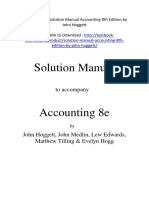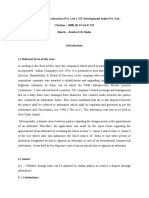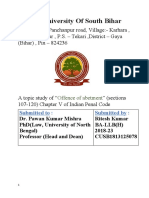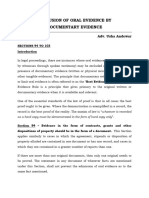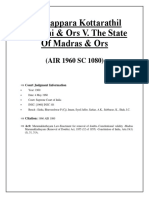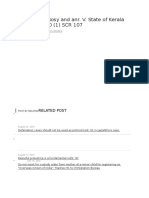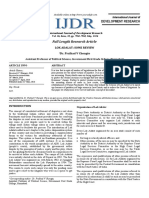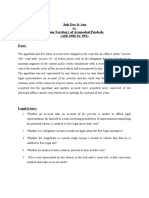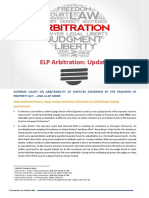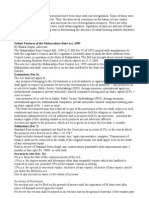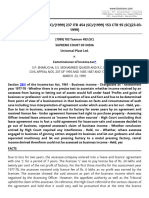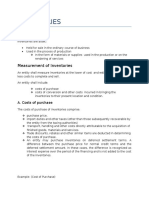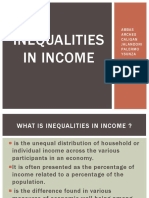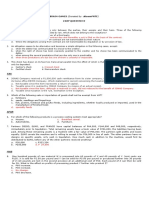Bikaner Gypsums LTD Edited For Print
Bikaner Gypsums LTD Edited For Print
Uploaded by
grmjain08Copyright:
Available Formats
Bikaner Gypsums LTD Edited For Print
Bikaner Gypsums LTD Edited For Print
Uploaded by
grmjain08Original Description:
Original Title
Copyright
Available Formats
Share this document
Did you find this document useful?
Is this content inappropriate?
Copyright:
Available Formats
Bikaner Gypsums LTD Edited For Print
Bikaner Gypsums LTD Edited For Print
Uploaded by
grmjain08Copyright:
Available Formats
Bikaner Gypsums Ltd. v. C.I.T.
(1991) 1 SCC 328
Facts. The assesse company , Bikaner Gypsums Ltd. , acquired a lease from the State of Rajasthan , for mining of gypsum for a period of 20 years over an area of 4.27 square miles at Jamsar. the Bikaner Gypsums Ltd., a company wherein the State Government owned 45 per cent share. The assessee carried on the business of mining gypsum in accordance with the terms and conditions stated in the lease. Under the lease, the assessee was conferred the liberties and powers to enter upon the entire leased land and to search for, win, work, get, raise, convert and carry away the gypsum for its own benefits in the most economic, convenient and beneficial . However the lease agreement imposed certain restrictions on the company . It provided that the lessee shall not enter upon or occupy surface of any land in the occupation of any tenant or occupier without making reasonable compensation to such tenant or occupier. It also provided restriction on mining operation within 100 yards from any railway, reservoir, canal or other public works. This clause had been incorporated in the lease to protect the railway track and railway station which was situated within the area demised to the lessee. The assessee company exclusively carried on the mining of gypsum in the entire area demised to it. The railway authorities extended the railway area by laying down fresh track, providing for railway siding. The railways further constructed quarters in the lease area without the permission of the assessee company. The assessee company filed a suit in civil court for ejecting the railways from the encroached area but it failed in the suit. However after negotiations between the assesse company and Railway authorities, the Railway Board agreed to shift the railway station, track and yards to another place or area offered by the assessee. Under the agreement the railway authorities agreed to shift the station and all its establishments to the alternative site offered by the assessee on the condition
that the assessee company shall pay Rs 3 lakhs to the Railways towards the cost of shifting of the railway station and other constructions. The assessee company claimed deduction of Rs 3 lakhs paid to the Railway for the shifting of the railway station for the relevant assessment year . The Income Tax Officer rejected the assessees claim on the ground that it was a capital expenditure. On appeal ,the Income Tax Appellate Tribunal held that the payment of Rs 3 lakhs by the assessee company was not a capital expenditure, instead it was a revenue expenditure. On reference from the Tribunal, the High Court held that since on payment of Rs 3 lakhs to the railways the assessee acquired a new asset which was attributable to capital of enduring nature, the sum of Rs 3 lakhs was a capital expenditure and it could not be a revenue expenditure. On these findings the High Court answered the question in the negative in favour of the revenue against the assessee and it set aside the order of the Tribunal by the impugned order. The assesse company came in appeal to the Supreme Court against the order of the High Court.
Contention of the Company. It was contended that since the entire area had been leased out to the assessee for carrying out mining operations, the assessee had right to win the minerals which lay under the Railway Area as that land had also been demised to the assessee. Since the existence of railway station, building and yard obstructed the mining operations, the assessee paid the amount of Rs 3 lakhs for removal of the same with a view to carry on its business profitably. The assessee did not acquire any new asset, instead, it merely spent money in removing the obstruction to facilitate the mining in a profitable manner. Contention of the Revenue. In view of the restrictions imposed by the lease, the assessee had no right to the surface of the land occupied by the railways.
The assessee acquired that right by paying Rs 3 lakhs which resulted into an enduring benefit to it. It was a capital expenditure.
Reasoning of the Court. The question whether a particular expenditure incurred by the assessee is of capital or revenue nature is a vexed question which has always presented difficulty before the courts. There are a number of decisions of this Court and other courts formulating tests for distinguishing the capital from revenue expenditure. But the tests so laid down are not exhaustive and it is not possible to reconcile the reasons given in all of them, as each decision is founded on its own facts and circumstances. In Assam Bengal Cement Co. Ltd. v. CIT [(1955) 1 SCR 972] , the Supreme Court observed that in the great diversity of human affairs and the complicated nature of business operation, it is difficult to lay down a test which would apply to all situations. One has, therefore, to apply the criteria from the business point of view in order to determine whether on fair appreciation of the whole situation the expenditure incurred for a particular matter is of the nature of capital expenditure or a revenue expenditure. The court laid down a simple test for determining the nature of the expenditure. It observed : If the expenditure is made for acquiring or bringing into existence in asset or advantage for the enduring benefit of the business it is properly attributable to capital and is of the nature of capital expenditure. If on the other hand it is made not for the purpose of bringing into existence any such asset or advantage but for running the business or working it with a view to produce the profits it is a revenue expenditure. If any such asset or advantage for the enduring benefit of the business is thus acquired or brought into existence it would be immaterial whether the source of the payment was the capital or the income of the concern or whether the payment was made once and for all or was made periodically. The aim and object of the expenditure would determine the character of the expenditure whether it is a capital expenditure or a revenue expenditure.
In Abdul Kayoom v. CIT [(1962) 44 ITR 589] the Supreme Court after considering a number of English and Indian authorities held that each case
depends on its own facts, and a close similarity between one case and another is not enough, because even a single significant detail may alter the entire aspect. The court observed that what is decisive is the nature of the business, the nature of the expenditure, the nature of the right acquired, and their relation inter se, and this is the only key to resolve the issue in the light of the general principles, which are followed in such cases. In Kayooms case the assessee claimed deduction of Rs 6111 paid by it to the government as lease money for the grant of exclusive rights to fish and carry away all shells in the sea off the coast line of a certain area specified in the lease for a period of three years. The court held that the amount of Rs 6111 was paid to obtain an enduring benefit in the shape of an exclusive right to fish; the payment was not related to the shells , instead it was an amount spent in acquiring an asset from which it may collect its stock-in-trade. It was, therefore, an expenditure of a capital nature.
In Bombay Steam Navigation Co. Pvt. Ltd. v. CIT [(1965) 1 SCR 770] the assessee purchased the assets of another company for purposes of carrying on passenger and ferry services, it paid part of the consideration leaving the balance unpaid. Under the agreement of sale the assessee had to pay interest on the unpaid balance of money. The assessee claimed deduction of the amount of interest paid by it under the contract of purchase from its income. The court held that the claim for deduction of amount of interest as revenue expenditure was not admissible. The court observed that while considering the question the court should consider the nature and ordinary course of business and the object for which the expenditure is incurred. If the outgoing or expenditure is so related to the carrying on or conduct of the business, that it may be regarded as an integral part of the profit-earning process and not for acquisition of an asset or a right of a permanent character, the possession of which is a condition for the carrying on of the business, the expenditure may be regarded as revenue expenditure. But, on the facts of the case, the court held that the assessees claim was not admissible, as the expenditure was related to the acquisition of an asset or a right of a permanent character, the possession of which was a condition for carrying on the business.
In Moolchand Suganchand v. CIT [(1972) 86 ITR 647] the assessee was carrying on a mining business and had paid a sum of Rs 1,53,800 to acquire lease of certain areas of land bearing mica for a period of 20 years. In addition , the assesse also had paid a sum of Rs 3200 as fee for a licence for prospecting for emerald for a period of one year. The assessee claimed the expenditure of Rs 3200 paid by it as fee to the government for prospecting licence as revenue expenditure. The assessee further claimed that the appropriate part of Rs 1,53,800 paid by it as lease money was allowable as revenue expenditure. The court held that while considering the question in relation to the mining leases an empirical test is that where minerals have to be won, extracted and brought to surface by mining operations, the expenditure incurred for acquiring such a right would be of a capital nature. But, where the mineral has already been gotten and is on the surface, then the expenditure incurred for obtaining the right to acquire the raw material would be a revenue expenditure. The court held that since the payment of tender money for lease right was for acquisition of capital asset, the same could not be treated as a revenue expenditure. As regards the claim relating to the prospecting licence fee of Rs 3200 the court held that since the licence was for prospecting only and as the assessee had not started working a mine, the payment was made to the government with the object of initiating the business. The court held that even though the amount of prospecting licence fee was for a period of one year, it did not make any difference as the fee was paid to obtain a licence to investigate, search and find the mineral with the object of conducting the business, extracting ore from the earth necessary for initiating the business.
In the present case , the assessee never claimed any deduction with regard to the licence fee or royalty paid by it, instead, the claim relates to the amount spent on the removal of a restriction which obstructed the carrying of the business of mining within a particular area in respect of which the assessee had already acquired mining rights. The payment of Rs 3 lakhs for shifting of the railway track and railway station was not made for initiating the business of mining operations or for acquiring
any right, instead the payment was made to remove obstruction to facilitate the business of mining. The principles laid down in Suganchand case do not apply to the instant case. In British Insulated and Helsby Cables Ltd. case [1926 AC 205], the test laid down therein has almost universally been accepted. It was observed that: When an expenditure is made, not only once and for all, but with a view to bringing into existence an asset or an advantage for the enduring benefit of a trade, there is very good reason (in the absence of special circumstances leading to an opposite conclusion) for treating such an expenditure as properly attributable not to revenue but to capital. This dictum has been followed and approved by the Supreme Court in the cases of Assam Bengal Cement Co. Ltd., Abdul Kayoom and Seth Suganchand and several other decisions . But, the test laid down In British Cables case has been explained in a number of cases which show that the tests for considering the expenditure for the purposes of bringing into existence, as an asset or an advantage for the enduring benefit of a trade is not always true . Therefore, the test laid down was not a conclusive one and it was recognised that special circumstances might very well lead to an opposite conclusion. In Gotan Lime Syndicate v. CIT [(1966) 59 ITR 718] the assessee which carried on the business of manufacturing lime from limestone, was granted the right to excavate limestone in certain areas under a lease. Under the lease the assessee had to pay royalty of Rs 96,000 per annum. The assessee claimed the payment of Rs 96,000 to the government as a revenue expenditure. The Supreme Court held that the royalty paid by the assessee has to be allowed as revenue expenditure as it had relation to the raw materials to be excavated and extracted. The court observed that the royalty payment had relation to the lime deposits. Although the assessee did derive an advantage and further even though the advantage lasted at least for a period of five years , only an annual royalty was paid. The court held that the royalty was not a direct payment for securing an enduring benefit, instead it had relation to the raw materials to be obtained. In this decision expenditure for securing an advantage which was to last at least for a period of five years was not treated to have enduring benefit. In M.A. Jabbar v. CIT [(1968) 2 SCR 413], the assessee was carrying on the business of supplying lime and sand, and for the purposes of acquiring sand he
had obtained a lease of a river bed from the State Government for a period of 11 months. Under the lease he had to pay large amount of lease money for the grant of an exclusive right to carry away sand within, under or upon the land. The assessee claimed deduction with regard to the amount paid as lease money. The court held that the expenditure incurred by the assessee was not related to the acquisition of an asset or a right of permanent character instead the expenditure was for a specific object of enabling the assessee to remove the sand lying on the surface of the land which was stock-in-trade of the business, therefore, the expenditure was a revenue expenditure.
Whether payments made by an assessee for removal of any restriction or obstacle to its business would be in the nature of capital or revenue expenditure, has been considered by courts. In Commissioner of Inland Revenue v. Canon Company [(1966-69) 45 Tax Cas 18] the assessee carried on the business of iron founders which was incorporated by a Charter granted to it in 1773. The Charter of the company placed restriction on the companys borrowing powers. The company decided to petition for a supplementary Charter providing for the removal of the limitation on companys borrowing powers . The companys petition was contested by dissenting shareholders in court. The company settled the litigation under which it had to pay the cost of legal action and buy out the holdings of the dissenting shareholders and in pursuance thereof a supplementary Charter was granted. In assessment proceedings, the company claimed deduction of payments made by it towards the cost of obtaining the Charter, the amounts paid to the dissenting shareholders and expenses in the action. The House of Lords held that since the object of the new Charter was to remove obstacle to profitable trading, and removal of restrictions on borrowing facilitated the day-to-day trading operation of the company, the expenditure was on revenue account. The House of Lords considered the test laid down in British Cables case and held that the payments made by the company, were for the purpose of removing of disability of the companys trading operation which prejudiced its operation. This was achieved without acquisition of any tangible or intangible asset or without creation of any new branch of trading activity. From a commercial and business point of view nothing in the nature of additional fixed capital was thereby achieved. The court pointed out that there is a sharp distinction between the removal of a disability on one hand payment for which is a revenue
payment, and the bringing into existence of an advantage, payment for which may be a capital payment. Since, in the case before the court, the company had made payments for removal of disabilities which confined their business under the out of date Charter of 1773, the expenditure was on revenue account. In Empire Jute Company v. CIT [(1980) 124 ITR 1], the Supreme Court held that expenditure made by an assessee for the purpose of removing the restriction on the number of working hours with a view to increase its profits, was in the nature of revenue expenditure. The court observed that if the advantage consists merely in facilitating the assessees trading operations or enabling the management and conduct of the assessees business to be carried on more efficiently or more profitably while leaving the fixed capital untouched, the expenditure would be on revenue account even though the advantage may endure for an indefinite future. The view taken in the Canon Company and Empire Jute case is correct. Where the assessee has an existing right to carry on a business, any expenditure made by it during the course of business for the purpose of removal of any restriction or obstruction or disability would be on revenue account, provided the expenditure does not acquire any capital asset. Payments made for removal of restriction, obstruction or disability may result in acquiring benefits to the business, but that by itself would not acquire any capital asset. In the instant case the assessee had been granted mining lease under which he had right to quarry and extract mineral i.e. the gypsum and in that process he had right to dig the surface of the entire area leased out to him. However the lease agreement placed a restriction on his right to mining operations from the Railway Area, but that area could also be operated by it for mining purposes with the permission of the authorities. The assessee had under the lease acquired full right to carry on mining operations in the entire area including the Railway Area. The payment of Rs 3 lakhs was not made by the assessee for the grant of permission to carry on mining operations within the Railway Area, instead the payment was made towards the cost of removing the construction which obstructed the mining operations. The presence of the railway station and railway track was operating as an obstacle to the assessees business of mining, the assessee made the payment to remove that obstruction to facilitate the mining operations. On the payment made to the railway authorities the assessee
did not acquire any fresh right to any mineral nor he acquired any capital asset instead the payment was made by it for shifting the railway station and track which operated as hindrance and obstruction to the business or mining in a profitable manner. The assessee had already paid tender money, licence fee and other charges for securing the right of mining in respect of the entire area including the right to the minerals under the Railway Area. The High Court failed to appreciate that the lease agreement only placed restrictions on mining in railway area and it did not destroy the assessees right to the minerals found under the Railway Area. The restriction operated as an obstacle to the assessees right to carry on business in a profitable manner. The assessee paid a sum of Rs 3 lakhs towards the cost of removal of the obstructions which enabled the assessee to carry on its business of mining in an area which had already been leased out to it for that purpose. There was, therefore, no acquisition of any capital asset. Therefore the High Courts view that the benefit acquired by the assessee on the payment of the disputed amount was a benefit of an enduring nature is not sustainable in law. As already observed, there may be circumstances where expenditure, even if incurred for obtaining advantage of enduring benefit may not amount to acquisition of asset. The facts of each case have to be borne in mind in considering the question having regard to the nature of business its requirement and the nature of the advantage in commercial sense. In considering the cases of mining business ,the nature of the lease the purpose for which expenditure is made, its relation to the carrying on of the business in a profitable manner should be considered. The payment made by the assessee was for removal of disability and obstacle and it did not bring into existence any advantage of an enduring nature. The Tribunal rightly allowed the expenditure on revenue account. The High Court in our opinion failed to appreciate the true nature of the expenditure. Therefore the appeal is allowed and the order of the High Court is set aside.
You might also like
- Full Solution Manual Accounting 8th Edition by John Hoggett SLW1014Document68 pagesFull Solution Manual Accounting 8th Edition by John Hoggett SLW1014Sm Help80% (5)
- Essential Soft Skills for Lawyers: What They Are and How to Develop ThemFrom EverandEssential Soft Skills for Lawyers: What They Are and How to Develop ThemNo ratings yet
- TDM Infrastructure Private Vs Ue Development India PVT - Ltd.Document2 pagesTDM Infrastructure Private Vs Ue Development India PVT - Ltd.Tosani LalNo ratings yet
- Property Law I Project, Ronak PatidarDocument18 pagesProperty Law I Project, Ronak PatidarsiddharthNo ratings yet
- Ravinder SinghDocument6 pagesRavinder Singhshivam jainNo ratings yet
- A Project Report On Criminal Procedure CODE, 1973.: Topic: Judgment (Section 353-365)Document23 pagesA Project Report On Criminal Procedure CODE, 1973.: Topic: Judgment (Section 353-365)Roma Gill100% (1)
- Mine Scams Gold OreDocument30 pagesMine Scams Gold OreAFLAC ............100% (1)
- Mondelz InternationalDocument63 pagesMondelz InternationalPranali DevlekarNo ratings yet
- Tamil Nadu Generation and Distribution Corporation Limited (TANGEDCO) v. Competition Commission of IndiaDocument2 pagesTamil Nadu Generation and Distribution Corporation Limited (TANGEDCO) v. Competition Commission of IndiaSakshi JainNo ratings yet
- Case Summary DOC-IPR2NotesDocument25 pagesCase Summary DOC-IPR2NotesSat ParkashNo ratings yet
- Case Summary - Sheela BarseDocument4 pagesCase Summary - Sheela BarsePragyaNo ratings yet
- Bacha F. Guzdar v. C.I.T., BombayDocument3 pagesBacha F. Guzdar v. C.I.T., BombayRonit KumarNo ratings yet
- Property Law 2 ProjectDocument20 pagesProperty Law 2 ProjectAakash ChauhanNo ratings yet
- TC 17 (Petitioners)Document26 pagesTC 17 (Petitioners)vani41021No ratings yet
- IPC Offence of Abetment RKDocument23 pagesIPC Offence of Abetment RKKriti vardhanNo ratings yet
- (Case Brief) Atiabari Tea Co. Ltd. V - S The State of Assam & Others - Supreme Court of India-1Document4 pages(Case Brief) Atiabari Tea Co. Ltd. V - S The State of Assam & Others - Supreme Court of India-1lavNo ratings yet
- Presentation On Case Indian Overseas Bank, Madras Vs Chemical Construction Company & Ors. 1979 (4) SCC 358Document8 pagesPresentation On Case Indian Overseas Bank, Madras Vs Chemical Construction Company & Ors. 1979 (4) SCC 358Adv Aastha MakkarNo ratings yet
- Maru Ram v. Union of India (1981) 1 SCC 107: E-Mail This Comments Print ArticleDocument52 pagesMaru Ram v. Union of India (1981) 1 SCC 107: E-Mail This Comments Print ArticlemohitpaliwalNo ratings yet
- Kruti Shah Moot Court No 1 Defendant PDF Free RemovedDocument26 pagesKruti Shah Moot Court No 1 Defendant PDF Free RemovedAMAN SINHANo ratings yet
- S M Dugar - Guide To Competition Law (7th Ed)Document1,256 pagesS M Dugar - Guide To Competition Law (7th Ed)CHITRA PRAKASHNo ratings yet
- BSA - Exclusion of Oral Evidence by Documentary EvidenceDocument5 pagesBSA - Exclusion of Oral Evidence by Documentary EvidenceHitanshi PandyaNo ratings yet
- Conclusive: of The Relevancy of FactsDocument96 pagesConclusive: of The Relevancy of Factsabhisek kaushalNo ratings yet
- Suit by Indegent Person.Document4 pagesSuit by Indegent Person.Śańthôsh Ķūmař PNo ratings yet
- LLB Paper Code: 410 (8 Sem) Subject: Interpretation of StatutesDocument23 pagesLLB Paper Code: 410 (8 Sem) Subject: Interpretation of StatutesTLCNo ratings yet
- Unit - 2, Topic - 3, ConciliationDocument23 pagesUnit - 2, Topic - 3, ConciliationAshutosh BagchiNo ratings yet
- Land Laws - M-3-4Document19 pagesLand Laws - M-3-4shiv rathoreNo ratings yet
- KK Kochuni V StateDocument15 pagesKK Kochuni V StateVani GuptaNo ratings yet
- Thakorilal D. Vadgama v. State of Gujarat: Case CommentDocument7 pagesThakorilal D. Vadgama v. State of Gujarat: Case CommentShreshtha Verma88% (8)
- Intellectuals Forum, Tirupathi v. State of A.P. AIR 2006 SC 1350 - (Public Trust Doctrine)Document4 pagesIntellectuals Forum, Tirupathi v. State of A.P. AIR 2006 SC 1350 - (Public Trust Doctrine)Soumiki GhoshNo ratings yet
- Ratilal Panachand Gandhi Vs The State of Bombay and ... On 18 March, 1954Document14 pagesRatilal Panachand Gandhi Vs The State of Bombay and ... On 18 March, 1954Shehzad HaiderNo ratings yet
- Crime Branch CID (Crime Investigation Department) (Sometimes Known AsDocument3 pagesCrime Branch CID (Crime Investigation Department) (Sometimes Known AsAbhijit TripathiNo ratings yet
- Moot Court Case 2Document7 pagesMoot Court Case 2Shravani wagheNo ratings yet
- Chanakya National Law University, Patna: Project Topic: Morgan Stanley Mutual Fund Vs Kartick DasDocument4 pagesChanakya National Law University, Patna: Project Topic: Morgan Stanley Mutual Fund Vs Kartick Dashuma gousNo ratings yet
- CONTEMPT LAW CONSTITUTIONAL VALIDITY by PATNA LAW COLLEGEDocument4 pagesCONTEMPT LAW CONSTITUTIONAL VALIDITY by PATNA LAW COLLEGECool dude 101No ratings yet
- Comoundable Non ComoundavleDocument7 pagesComoundable Non Comoundavleimrumy0% (1)
- Rosy V State of KerelaDocument5 pagesRosy V State of KerelaAshutosh Singh Parmar0% (1)
- Ratlam Case AnalysisDocument9 pagesRatlam Case AnalysiskanupriyaNo ratings yet
- Retrospective Operation of Statutes Relating To Succession and Transfer.Document3 pagesRetrospective Operation of Statutes Relating To Succession and Transfer.ramanjeet singhNo ratings yet
- Legal Education and Reseach Complete NotesDocument176 pagesLegal Education and Reseach Complete NotesAeronikaNo ratings yet
- Asian Law College 1 National Moot Court Competition 2020: Memorial On Behalf of PetitionerDocument22 pagesAsian Law College 1 National Moot Court Competition 2020: Memorial On Behalf of PetitionerRishabh JainNo ratings yet
- Anversinh Alias Kiransinh Fatesinh Zala v. State of GujaratDocument3 pagesAnversinh Alias Kiransinh Fatesinh Zala v. State of Gujaratsupriya.su07No ratings yet
- ADR Negotiation Strategy PaperDocument10 pagesADR Negotiation Strategy PaperRAHUL KAMATH 1950125No ratings yet
- Property Law Ii - Internal Assesment Iii Case Comment On Shyam Narayan Prasad V. Krishna Prasad & Ors. AIR 2018 SC 3152Document11 pagesProperty Law Ii - Internal Assesment Iii Case Comment On Shyam Narayan Prasad V. Krishna Prasad & Ors. AIR 2018 SC 3152aayush chchaturvediNo ratings yet
- Legal Lang Sem2 AssignmentDocument7 pagesLegal Lang Sem2 AssignmentHelik SoniNo ratings yet
- Law of Crime-Summons Under Indian Criminal Procedure CodeDocument21 pagesLaw of Crime-Summons Under Indian Criminal Procedure CodeGanesh Ojha100% (1)
- Research Paper On Lok AdalatDocument3 pagesResearch Paper On Lok Adalatnaveen balwanNo ratings yet
- Suk Das & Anr vs. Union Territory of Arunachal Pardesh. (AIR 1986 SC 991) FactsDocument2 pagesSuk Das & Anr vs. Union Territory of Arunachal Pardesh. (AIR 1986 SC 991) FactsPriyanka PellonNo ratings yet
- Right To Property Before 44 Amendment To The Indian ConstitutionDocument16 pagesRight To Property Before 44 Amendment To The Indian ConstitutionOnindya MitraNo ratings yet
- Case Summary Copyrights 7 16Document130 pagesCase Summary Copyrights 7 16Chintakayala SaikrishnaNo ratings yet
- Maxwell On The Interpretation of Statutes by P. St. J. Langan - Chapter 1 - 4Document104 pagesMaxwell On The Interpretation of Statutes by P. St. J. Langan - Chapter 1 - 4Adv. Abhinav JainNo ratings yet
- Nupur Gupta - Zee Telefilms v. UOIDocument8 pagesNupur Gupta - Zee Telefilms v. UOINeha GuptaNo ratings yet
- Ios - 2018 5 SEMDocument51 pagesIos - 2018 5 SEMAmit ThokeNo ratings yet
- Vidya Drolia and Ors.v.Durga Trading Corporation (2020 SCCOnLine SC 1018) SynopsisDocument5 pagesVidya Drolia and Ors.v.Durga Trading Corporation (2020 SCCOnLine SC 1018) SynopsisJahnaviSinghNo ratings yet
- Case Summary - Aureliano Fernandes v. State of Goa and Ors.Document3 pagesCase Summary - Aureliano Fernandes v. State of Goa and Ors.aditi kundu100% (2)
- Maha Rent Control Act Net MaterialDocument10 pagesMaha Rent Control Act Net MaterialYashwant GoswamiNo ratings yet
- Law of Evidence: "Competency of Witnesses (Sections:-118 - 134) "Document25 pagesLaw of Evidence: "Competency of Witnesses (Sections:-118 - 134) "Pridhi SinglaNo ratings yet
- The Working Journalist (Fixation OF WAGES ACT), 1958Document8 pagesThe Working Journalist (Fixation OF WAGES ACT), 1958Vipul Partap100% (1)
- Visual and Non Visual MediaDocument4 pagesVisual and Non Visual MediaGumliNo ratings yet
- Onus Probandi: Chenchamma & Anr., 1964 AIR 136 Held That There Is An Essential Distinction BetweenDocument1 pageOnus Probandi: Chenchamma & Anr., 1964 AIR 136 Held That There Is An Essential Distinction BetweenSiddhant RadhuNo ratings yet
- Legitimate Expectations, Judicial Review and TribunalsDocument29 pagesLegitimate Expectations, Judicial Review and TribunalsPratik Harsh100% (1)
- Moot Court - Viva QuestionsDocument4 pagesMoot Court - Viva Questionsdaradivyakumari100% (1)
- 1999 103 Taxman 493 SC 1999 237 ITR 454 SC 1999 153 CTR 95 SC 23 03 1999 UniveDocument10 pages1999 103 Taxman 493 SC 1999 237 ITR 454 SC 1999 153 CTR 95 SC 23 03 1999 UniveAnanya SNo ratings yet
- Contents of ProspectusDocument27 pagesContents of ProspectusNishanthi PriyaNo ratings yet
- Measurement of InventoriesDocument24 pagesMeasurement of InventoriesthenikkitrNo ratings yet
- DissertationDocument38 pagesDissertationwedjefdbenmcve100% (1)
- Quiz - PartnershipDocument2 pagesQuiz - PartnershipLeisleiRagoNo ratings yet
- The Case For Yield Investing: SchrodersDocument6 pagesThe Case For Yield Investing: SchrodersnigeltaylorNo ratings yet
- MAN385 - Global Management - Doggett - 04425Document10 pagesMAN385 - Global Management - Doggett - 04425manojks17No ratings yet
- Capital BudgetingDocument68 pagesCapital Budgetingbemerkung100% (1)
- Financial Department: Hindustan Construction CompanyDocument7 pagesFinancial Department: Hindustan Construction CompanyRahul SwarraazNo ratings yet
- Essay Question For Int Acc 2011Document2 pagesEssay Question For Int Acc 2011Extraordinary IraNo ratings yet
- Inequalities in Income 2Document25 pagesInequalities in Income 2RencyVillanueva100% (1)
- The 2007 AlwaysOn Top 100 Private CompaniesDocument4 pagesThe 2007 AlwaysOn Top 100 Private CompaniesAlwaysOnNo ratings yet
- Equity Analysis at Ventura SecuritiesDocument63 pagesEquity Analysis at Ventura SecuritiesManishKumarNo ratings yet
- Order Against Ishita Consultancy Private LTD in Respect of Dealings in The Scrip of Riba Textiles LimitedDocument11 pagesOrder Against Ishita Consultancy Private LTD in Respect of Dealings in The Scrip of Riba Textiles LimitedShyam SunderNo ratings yet
- Draft Letter To European CommissionDocument16 pagesDraft Letter To European CommissionAna PredaNo ratings yet
- Market Risk Premium PDFDocument3 pagesMarket Risk Premium PDFmelinaguimaraesNo ratings yet
- Demon of Our Own DesignDocument3 pagesDemon of Our Own DesignNeil GriggNo ratings yet
- Amit ProjectDocument121 pagesAmit ProjectsmsmbaNo ratings yet
- ACCT 621 Practicing 1Document3 pagesACCT 621 Practicing 1Hashitha100% (1)
- Ethics of Executive CompensationDocument15 pagesEthics of Executive CompensationmanbranNo ratings yet
- CHAPTER 3 - Partnership Dissolution - Changes in OwnershipDocument16 pagesCHAPTER 3 - Partnership Dissolution - Changes in OwnershipRominna Dela RuedaNo ratings yet
- CalasanzDocument8 pagesCalasanzGenesis LealNo ratings yet
- Kalaari Capital Advisors Deal DetailsDocument4 pagesKalaari Capital Advisors Deal DetailsNikhilesh ChaudharyNo ratings yet
- NFJPIA (Region XI) Brain GamesDocument6 pagesNFJPIA (Region XI) Brain GamesRonieOlarteNo ratings yet
- ACCT 100-Principles of Financial Accounting - Atifa Dar - Omair HaroonDocument7 pagesACCT 100-Principles of Financial Accounting - Atifa Dar - Omair HaroonAbdelmonim Awad OsmanNo ratings yet
- Accounting For Partnership - Basic ConceptsDocument19 pagesAccounting For Partnership - Basic ConceptsAashutosh PatodiaNo ratings yet
- ReturnDocument15 pagesReturnNurqasrina AisyahNo ratings yet
- Form - VA: Asset DeclarationDocument5 pagesForm - VA: Asset DeclarationSankalp KumarNo ratings yet
